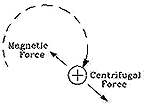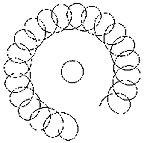|
The ring current
Because positive ions and negative electrons drift in opposite directions (see drawing), that motion will create an electric current that circulates clockwise around the Earth when viewed from north. The current is aptly named the ring current.
Note how different electric currents in space are from those encountered in everyday life! Currents we use at home--for light, to drive machinery or to generate heat--only flow if pushed by an electric pressure or voltage, against the resistance of the circuitry. The flow of such currents is in many ways similar to the flow of water through a pipe--water, too, will only flow if pressure is available, to help it overcome the friction inside the pipe. The flow of both water and electricity require a constant input of energy: once we click the switch and disconnect a house current from its source of voltage, it stops practically instantly.
The flow of the ring current, and of many other currents in space, is quite different. It needs neither a driving voltage nor an energy input, but persists as long as its ions and electrons are trapped in the magnetic field. Many aspects of such "collision-free plasmas" are quite unlike what one might expect, and are often hard to reproduce in the laboratory: that is why the magnetosphere is probably our best "natural laboratory" for studying the processes of distant space.
Magnetic storms
The magnetic field produced by the ring current contributes (rather slightly) to the magnetic field observed at the surface of the Earth. There are however times when the population of trapped particles is greatly reinforced. The ring current then becomes stronger and its magnetic effect at Earth may grow 10-fold or more: that is known as a magnetic storm. The reinforcing particles are generally of moderate energy, but can be quite numerous.
If trapped orbits are so stable that their particles cannot be easily lost, those particles should not be able to easily enter them, either. How then can the radiation belt and ring current arise?
The inner radiation belt, discovered by Explorers 1 and 3, turns out to be a slowly accumulating by-product of cosmic radiation.
The ring current however (its energetic part is often called the "outer radiation belt"), owes its existence to magnetic storms, which can replenish it in the matter of hours. The process by which that happens is still incompletely understood, but it involves electric forces, combining with magnetic ones. Electric fields are able to push trapped particles earthward, and unlike the purely magnetic motion described earlier, an electric field can also energize them.
The ultimate source of the energy and electric field must be the solar wind, and theories exist to explain how they are transmitted. Some are mentioned in futher sections, but many details are still unclear and controversial.
| 


 Official GSFC Home Page
Official GSFC Home Page  NASA WWW Home Page
NASA WWW Home Page